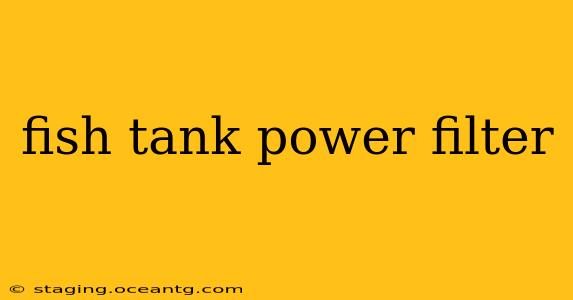Choosing the right power filter for your fish tank is crucial for maintaining a healthy aquatic environment. A well-functioning filter keeps your water clean, clear, and safe for your finned friends. This comprehensive guide will help you navigate the world of fish tank power filters, covering everything from understanding filter types to selecting the best one for your specific needs.
What is a Fish Tank Power Filter?
A fish tank power filter is a mechanical device that removes waste products, debris, and other impurities from your aquarium water. Unlike other filtration methods, power filters use a pump to draw water through a series of filter media, cleaning it before returning it to the tank. This continuous process is essential for maintaining water quality and the overall health of your fish. They are a cornerstone of any successful aquarium setup, regardless of size.
How Do Fish Tank Power Filters Work?
Power filters work through a simple yet effective process:
- Water Intake: The filter's intake tube draws water from the tank.
- Filtration Process: The water passes through various filter media, typically including mechanical, biological, and chemical components.
- Mechanical Filtration: This stage removes larger debris like uneaten food and fish waste.
- Biological Filtration: This is arguably the most important step. Beneficial bacteria colonize the filter media, breaking down harmful ammonia and nitrite into less toxic nitrate.
- Chemical Filtration: This stage uses activated carbon or other media to remove impurities, discoloration, and odors from the water.
- Water Output: Clean, filtered water is returned to the tank, creating a constant cycle of filtration.
What are the Different Types of Fish Tank Power Filters?
Several types of power filters cater to various tank sizes and setups:
- Hang-on-back (HOB) Filters: These are the most common type, easily attached to the back of the tank. They are relatively inexpensive and easy to maintain, making them ideal for beginners.
- Internal Filters: These filters sit submerged inside the tank. They are space-saving and suitable for smaller aquariums.
- Canister Filters: These powerful filters are placed outside the tank, providing superior filtration capabilities. They are best suited for larger tanks and experienced aquarists.
- Undergravel Filters (UGF): These filters use air pumps to circulate water through a gravel bed, but are less popular than the other types due to limitations in efficient biological filtration.
What Size Power Filter Do I Need for My Tank?
The appropriate filter size depends on your tank's volume and the number of fish you keep. A good rule of thumb is to choose a filter with a flow rate that circulates the entire tank's water volume at least four times per hour. Over-filtration is generally better than under-filtration, but excessively powerful filters can stress smaller fish. Always check the manufacturer's specifications and consider the bioload (the amount of waste produced by your fish).
How Often Should I Clean My Fish Tank Power Filter?
Cleaning frequency depends on several factors, including filter type, tank size, and bioload. While mechanical media (like filter floss) can be cleaned weekly, biological media (like ceramic rings or filter sponges) should only be rinsed gently in used aquarium water to avoid killing beneficial bacteria. Avoid using tap water, which contains chlorine and chloramine that are harmful to beneficial bacteria.
How Do I Choose the Right Filter Media for My Fish Tank?
Filter media plays a vital role in the effectiveness of your power filter. A good combination usually includes:
- Mechanical Media: Filter floss or pads to remove large particles.
- Biological Media: Ceramic rings, bio-balls, or filter sponges to support the growth of beneficial bacteria.
- Chemical Media: Activated carbon to remove impurities, though this needs to be changed regularly.
What are the Signs of a Failing Fish Tank Power Filter?
A malfunctioning filter can quickly lead to water quality problems. Look out for these warning signs:
- Cloudy water: Indicates insufficient filtration.
- Strong odor: Suggests a buildup of waste products.
- Reduced water flow: Could indicate a clogged filter or a malfunctioning pump.
- Visible debris in the tank: Signifies inadequate mechanical filtration.
By carefully considering these aspects, you can choose the right power filter to keep your aquarium thriving. Remember to research specific models and read reviews before purchasing. Maintaining a healthy and balanced aquarium is a rewarding experience – a properly functioning power filter is your key to success.
